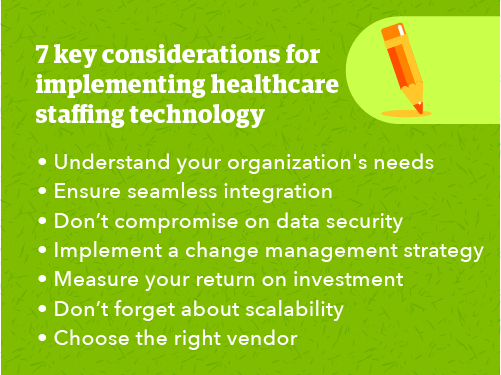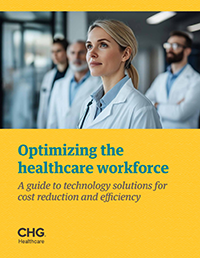
Healthcare organizations today face many challenges, including staffing shortages, surging labor costs, and increased demand for efficiency. While many technology solutions can help with these problems, it’s important to be thoughtful about how you select and implement them. Here are seven key considerations for successful healthcare staffing technology implementation.

1. Understand your organization's unique needs
Before purchasing any staffing technology product, evaluate your organization’s specific challenges. Perhaps turnover rates are worryingly high, scheduling processes are cumbersome, or recruitment efforts seem continually stalled.
Identifying these issues early on helps you choose a solution tailored precisely to your organization's needs rather than adopting a generic product that only partially addresses your problems.
2. Ensure seamless integration
One common oversight in adopting new technology is underestimating the importance of seamless integration. Ensuring compatibility with your current systems—like electronic health records (EHRs), payroll, and scheduling platforms—is vital. The smoother the data flows between systems, the fewer complications you'll face, ultimately saving valuable staff time.
When shopping around for solutions, make sure you understand how well a vendor’s technology integrates with your existing infrastructure, checking particularly for robust APIs. By understanding any technical hurdles upfront, you can avoid costly surprises later.
Understand the landscape: 7 telehealth trends in 2025
3. Don’t compromise on data security
Given the sensitivity of patient and employee data, every new technology you implement must comply with strict regulations, especially HIPAA. Scrutinize your vendor's security measures, such as encryption methods, authentication protocols, and routine security updates.
For example, Locumsmart, a locum tenens VMS company, opts into third-party SOC1 and SOC2 audits annually. These audits examine how data is tracked, accessed, and privileged to ensure users can trust how Locumsmart handles their data.
It’s also wise to review the vendor’s history regarding data breaches. After all, even a minor breach could severely damage patient trust and lead to expensive fines.
4. Implement a change management strategy
Introducing new technology isn’t merely a technical shift, it’s also a cultural one. Staff comfortable with traditional practices may resist change, which can delay full platform adoption.
Organizations should create a change management strategy with the vendor's active involvement to mitigate this. Start by engaging stakeholders early, clearly communicating the new system's benefits, and providing thorough training and reliable ongoing support. Successful implementation of a new technology is often as much about managing people as it is about managing new processes and products.
5. Measure your return on investment
To truly gauge the success of your newly implemented staffing technology, outline clearly how you'll measure its effectiveness. Conducting an ROI analysis upfront helps determine if the benefits justify the costs.
Establish clear key performance indicators, such as reduced agency costs, improved staff retention, or lower labor expenses. Having these metrics defined from the beginning helps to ensure you'll accurately track improvements in these areas and better understand how the new technology has affected various metrics.
Make improvements: 5 strategies for optimizing your healthcare workforce

6. Don’t forget about scalability
Healthcare organizations constantly evolve, and your technology solutions must keep pace. Selecting a scalable workforce solution that adapts easily to future demands will save headaches later. While you may not need all of the features a particular platform offers now, they may be helpful in the future. Likewise, some platforms may start relatively bare bones but have plans to add features in the coming months or years.
Ask potential vendors about their plans for future enhancements, growth capabilities, and ongoing innovations. Choosing technology that scales alongside your organization ensures that today's investment continues to pay off.
7. Choose the right vendor
Perhaps the most critical step in this process is picking the right technology partner. Thoroughly evaluate vendors based on their ability to meet your specific needs, their reliability, and the quality of their ongoing support.
Deb Gugel, a faculty recruiter from the University of Wisconsin School of Medicine and Public Health, suggests contacting peers who've already implemented similar solutions. “Ask them what has worked, what pitfalls to avoid, and for any insights they might have,” Gugel advises. “Learning from others' experiences can greatly shorten your learning curve.”
Take your time assessing factors such as implementation timelines, overall costs, and training quality. Being thorough at this stage ensures you choose a partner that aligns with your organization's long-term goals.
Thoughtful implementation is crucial
Adopting healthcare staffing technology isn’t something to rush into without careful planning. By thoughtfully implementing a new platform or product, your organization can successfully leverage technology to address staffing challenges, lower costs, and enhance patient care quality.
Want more information about implementing technology solutions into your healthcare staffing planning? Download the white paper by clicking the image below.

Contact CHG Healthcare today to learn how our innovative solutions can help you streamline operations, reduce costs, and drive better patient outcomes. Give us a call at 866.588.5996 or email ecs.contact@chghealthcare.com.
This article was created with the assistance of AI technology.